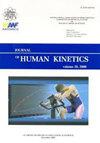利用节律性刺激评估运动时的血流和生理反应
IF 1.9
3区 医学
Q2 SPORT SCIENCES
引用次数: 0
摘要
活动和体力劳动会对人的心理物理状态和情感体验产生积极影响。人们对 "流动 "现象--一种感知到的唤醒状态--的兴趣源于它与个人内在动力的关系。包括体育在内的许多领域都在研究 "流动 "现象。如今,人们正在寻求解决方案,通过分析生理信号来支持对认知和情感状态的传统评估。因此,本研究分析并估计了在额外的元节奏刺激下,在运动间隙诱导流动状态时可能出现的生理反应。36 名健康受试者参加了研究。研究考察了各种节律刺激对受试者自由步态期间身体生理反应的影响。在改变单个刺激的速率和强制速率时,对生理反应和流动强度进行了评估。根据所进行研究的阶段和所经历的流动水平,确定了生理指标的几个具有统计意义的变量和相关性。流量和心率变异频率变量之间存在统计意义上的正相关。研究结果也证实了之前关于体育活动中流量响应与心率变异频率之间关系的文献报道。本文章由计算机程序翻译,如有差异,请以英文原文为准。
Flow and Physiological Response Assessment during Exercise Using Metrorhythmic Stimuli
Activity and physical effort positively affect a person's psychophysical state and emotional experience. Interest in the phenomenon of flow, the state of perceived arousal, stems from its relationship to an individual's intrinsic motivation. Flow is an area of research in many fields, including sports. Nowadays, solutions are being sought to support the traditional assessment of cognitive and affective states using analysis of physiological signals. Therefore, the present study analysed and estimated the physiological responses that may occur during the induction of a flow state between exercises stimulated by additional metrorhythmic stimuli. Thirty-six healthy subjects participated in the study. The effects of various metrorhythmic stimuli on the body's physiological response during the subjects' free gait were examined. The physiological response and flow intensity were evaluated when the rate of individual stimuli was changed, and the rate was enforced. Several statistically significant variables and correlations were determined for physiological indicators depending on the stage of the study conducted and the level of flow experienced. A positive, statistically significant correlation of flow and HRV frequency variables was obtained. The results also confirm previous literature reports on the relationship between flow response and frequency heart rate variability during physical activity.
求助全文
通过发布文献求助,成功后即可免费获取论文全文。
去求助
来源期刊

Journal of Human Kinetics
医学-运动科学
CiteScore
4.80
自引率
0.00%
发文量
83
审稿时长
3 months
期刊介绍:
The Journal of Human Kinetics is an open access interdisciplinary periodical offering the latest research in the science of human movement studies. This comprehensive professional journal features articles and research notes encompassing such topic areas as: Kinesiology, Exercise Physiology and Nutrition, Sports Training and Behavioural Sciences in Sport, but especially considering elite and competitive aspects of sport.
The journal publishes original papers, invited reviews, short communications and letters to the Editors. Manuscripts submitted to the journal must contain novel data on theoretical or experimental research or on practical applications in the field of sport sciences.
The Journal of Human Kinetics is published in March, June, September and December.
We encourage scientists from around the world to submit their papers to our periodical.
 求助内容:
求助内容: 应助结果提醒方式:
应助结果提醒方式:


